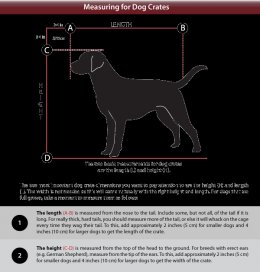Travel Dog Crates Medium
The following guide dog crate size guide has been put together to help you determine what size of dog crate will be best for your dog. In general, you will want to make sure that your dog can completely stand up inside of the dog crate. Your dog should also be able to lie down and turn around comfortably inside of the crate.
Generalized sizing
Most dog crate size guides will simply provide you with a list of breeds that are best suited for a size of dog crates. The specific dimensions for the various sizes, weight recommendations, breed recommendations and also some general information about dog crate sizing have been provided at the bottom of the page to allow you to make an educated decision for yourself. However, even if you see your dog breed listed for a particular dog crate, you should still take the other information into consideration because every dog is different.
Measuring for just the right size
The two most important dog crate dimensions you want to pay attention to are the height (H) and length (L). The width is not needed as this will come naturally with the right height and length. For dogs that are full grown, take a moment to measure them as follows.
- Find the height from the bottom of the front feet to the top of the head. Only include the ears for breeds that have erect ears.
- Measure how long they are from their nose to their tail. If your dog has a really long tail, you do not have to include the entire length, but you should account for some of it. For really thick, hard tails, you should measure more of the tail, or else it will whack on the cage every time they wag their tail.
If you do not have a full-grown dog, you should find out how big the dog breed gets and use those measurements.

Once you have your dog's height and length, depending on the size of the dog, add 2-4 inches (5-10 cm) to the height and the same to the length, or roughly 10%. Generally, add closer to 2 inches (5 cm) for smaller dogs and 4 inches (10 cm) for larger ones. Some people recommend adding 6 inches (15 cm).
These should be the minimum height and length measurements for the dog crate you buy. You should try not to go too far above those numbers either or else the dog will have too much room, and it may not be an effective crate training environment (since dogs are much more likely to relieve themselves in a crate with extra space).
Alternatively, for pet travel, you should add at least four inches for all dogs. It is ideal for your pet to have extra space during the travel process. Larger pet crates for travel and transport promotes better air flow and a comfortable environment for pet traveling.
See also:







